The EarthSky team and community will present the lowdown on not one comet – but two comets – possibly visible in Earth’s skies in October and early November, 2024. We’ll be there LIVE MONDAY (October 7) beginning at 12:15 p.m. CDT (17:15 UTC). Click in for a “notify me” button.
- Not one, but two comets might grace our skies in October 2024.
- Look west after sunset for Comet C/2023 A3 (Tsuchinshan-ATLAS) beginning around mid-October.
- Look east before sunrise for the sungrazer, Comet C/2024 S1 (ATLAS), beginning in late October
See the best images of Comet A3 in the morning sky here
Details on the sungrazer, Comet S1, here
Before it disappeared into the sunrise glare
Comet C/2023 A3 (Tsuchinshan-ATLAS) put on a fantastic show in the morning sky for Southern Hemisphere observers with dark skies and good optical aid in September and early October. See amazing images of the comet here. As of this writing (October 7), Comet A3 is now lost in the sun’s glare and not visible. But it’ll soon return to our evening sky.
Shortly before it was lost in the sunrise glare, observers around the world were reporting that they were starting to detect the comet with the unaided eye. Even the tail was (barely) visible without optical aid. But the best should be yet to come!
Comet A3 in early October 2024
Comet C/2023 A3 (Tsuchinshan–ATLAS) reached perihelion, or its closest point to the sun, on September 27, 2024. It’s now between the Earth and sun and not visible from Earth.
Comet A3 will be closest to Earth on October 12. Will it be visible that soon? Possibly. The comet is now passing almost directly between Earth and the sun, making it challenging to view.
Starting around October 14, Comet A3 will be easier to spot. See the charts below, which show the comet beginning around October 14, and on the following evenings. The comet’s great speed will cause it to appear noticeably higher in the western sky from one night to the next.
In late October, Comet A3 will pass rapidly in front of a series of constellations, including Serpens Caput and into Ophiuchus.
See our community photo gallery of the comet! It’s amazing
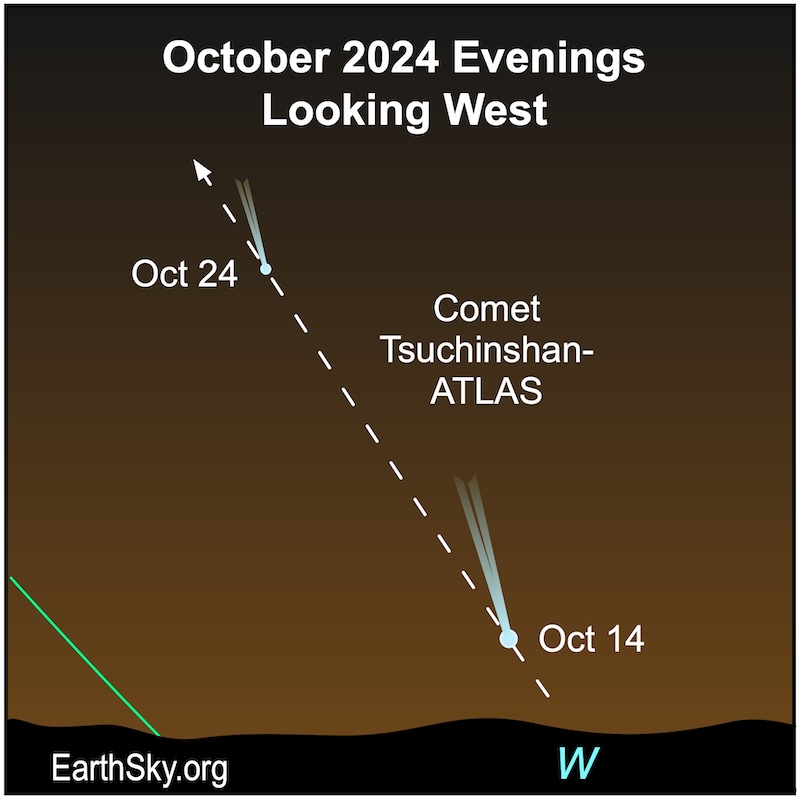
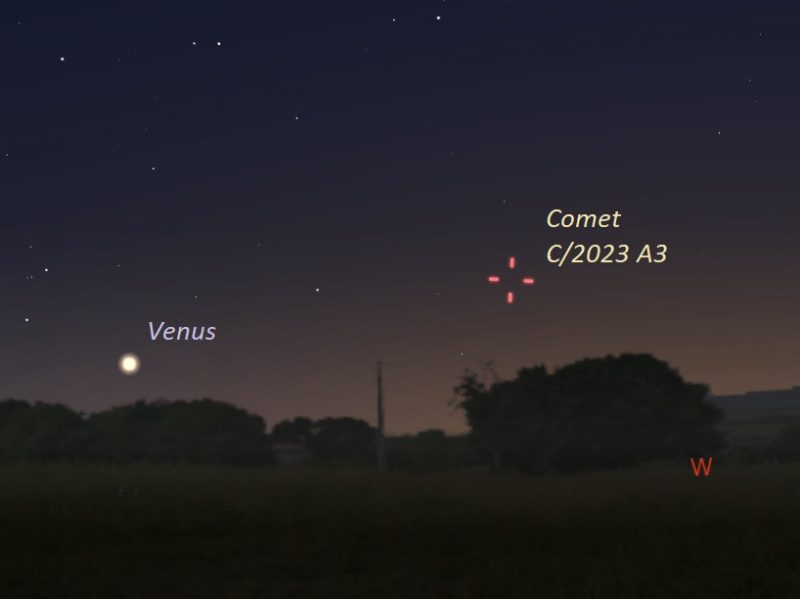

How bright? How easy to see?
Comets are unpredictable. And there’s no way to know at this time exactly how bright any comet will become. But preliminary estimates suggest that Comet A3 might grow as bright as magnitude 2.5 to 2 during closest approach to Earth on October 12. Or maybe even slightly brighter if we are lucky (or fainter if we’re unlucky), since comet behavior is so difficult to predict.
So Comet A3 isn’t going to be a Comet of the Century. But if it continues to perform well, it might be the brightest comet of the year … except for one other possibility.
Two bright comets in October?
There is a second comet in Earth’s skies that might become bright, in fact even brighter than Comet A3. The ATLAS survey in Hawaii found both of them.
Comet C/2024 S1 (ATLAS) is what’s known as a sungrazer. It was first given the designation of A11bP7I, but now it’s officially C/2024 S1 (ATLAS) … or Comet S1 for short. Predictions for the comet have it reaching as bright as magnitude -5 to -7 when it comes closest to the sun, at perihelion, on October 28. Those ranges would make the comet even brighter than the brightest planet, Venus. It might even be visible in the daytime sky. However, keep in mind that comets are notoriously unpredictable. The Southern Hemisphere will have the best view before perihelion. After its close encounter with the sun (if it survives!) – in late October and early November – it could put on a fantastic show for the Northern Hemisphere in the morning skies. It would definitely be something to wake up early for.
Details on the sungrazer, Comet S1, here

Helpful tips to spot a comet
1. Be sure you’re looking at the correct direction and time. Comet A3 will be visible low in the west after sunset beginning around October 14. Comet S1 will be visible in late October to early November, low in the east before sunrise.
2. You need a dark, unobstructed sky. Start looking when the sky is dark, but close to sunrise or sunset. Make sure there aren’t hills, trees or buildings blocking your view.
3. If you can’t see the comet with your eye, try your phone. Most cell phone cameras provide a night or low-light mode. But capturing an image of the comet will require that you hold the camera firmly – or lean against a fixed object like a tree – to avoid shaky or blurred images. Try taking a few pictures facing west after sunset (for Comet A3) or east before sunrise (for Comet S1). These images accumulate the light for a few seconds, so you might be able to catch the comet in your images, even if you can’t see it with the eye.
4. AFTER you’ve located the comet, use binoculars or your eyes to sweep in that area in the sky. You might discover that, in fact, you can see both the comet and its tail with your eye alone.
5. If you see it, try taking your own measurements of the comet’s tail. For example, if you take a good look through a pair of binoculars that has a 5-degree field of view, and you can see the tail extending about 3/5 of that field, you’re seeing around 3 degrees of the tail. And that means you are seeing with your own eyes a cometary tail that looks as long as six moon diameters!
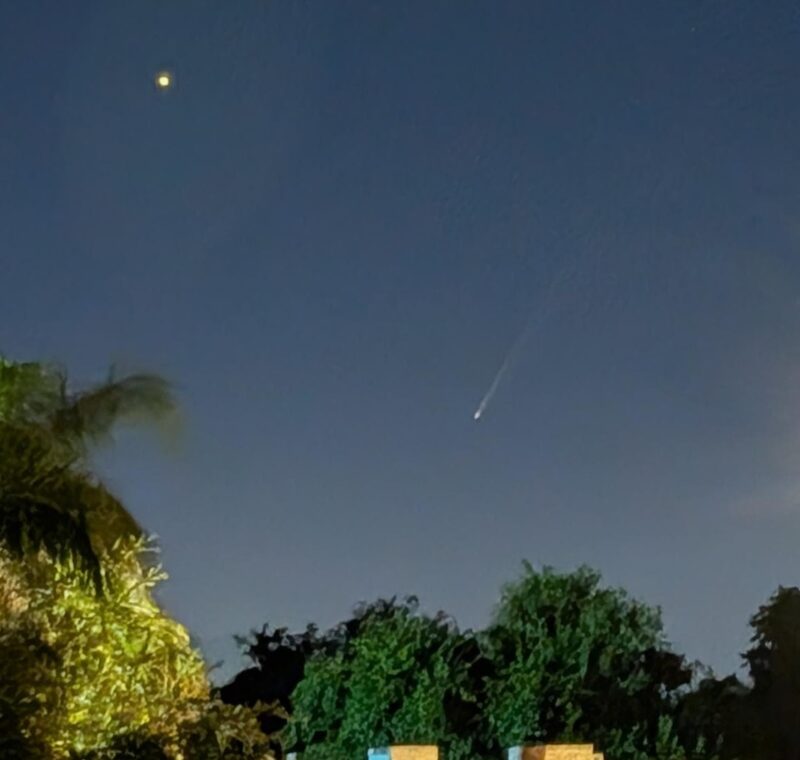
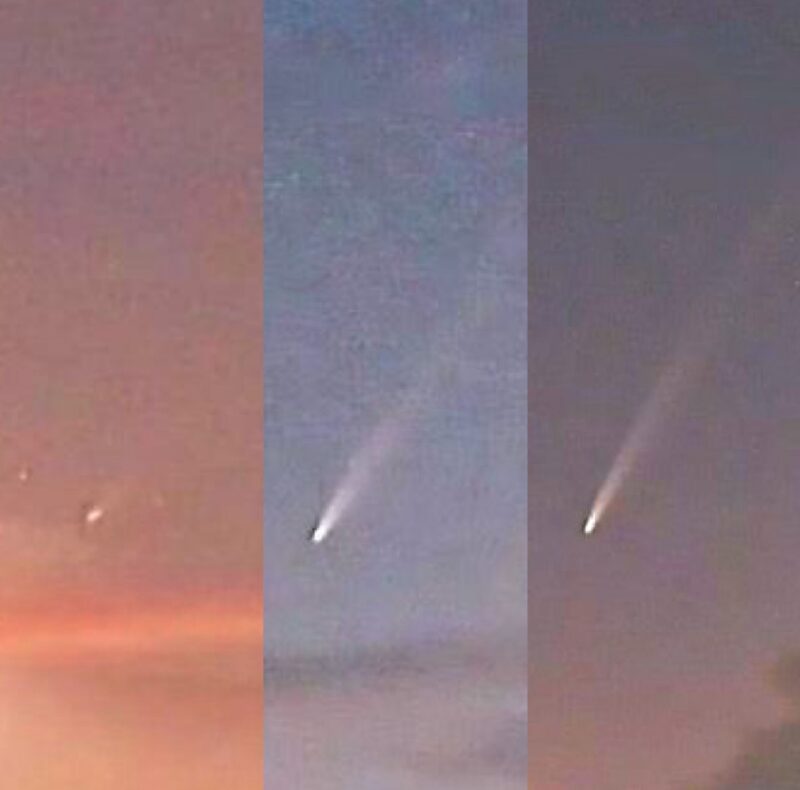
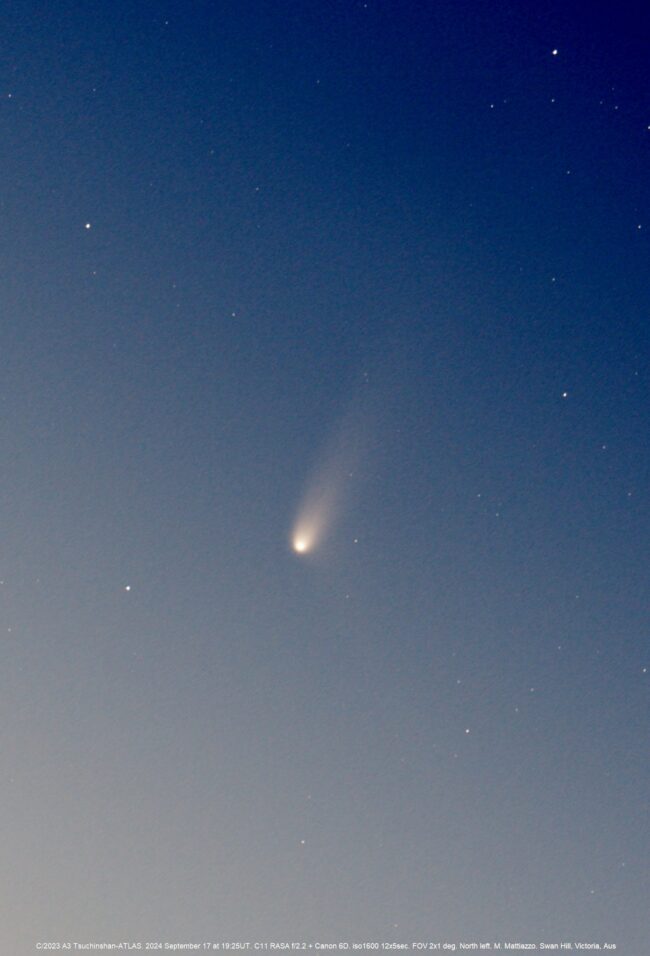
A speedy ball of ice and dust
Comet Tsuchinshan-ATLAS is blazingly speedy. It’s tearing through the inner solar system at 180,610 miles per hour (290,664 kph) or 80.74 km per second relative to Earth. With a small telescope, you can actually see its amazing speed. You can watch the comet’s location gradually change by comparing its exact position against background stars just 15 minutes later.
Comet A3 Tsuchinshan-ATLAS’s disintegration rumors
Comet A3 Tsuchinshan-ATLAS hasn’t been acting as people expected it to. As it was approaching the inner solar system in early 2024, it wasn’t brightening as much as expected. And then a study suggested the cometary nucleus was fragmenting.
The paper’s author, Zdenek Sekanina, a Czech-American astronomer and comet expert at NASA’s Jet Propulsion Laboratory, said, on July 8, 2024, that the comet entered an advanced phase of fragmentation. He said the end of Comet Tsuchinshan-ATLAS was inevitable.
However, comets are notorious for being erratic and unpredictable. And this one proved to be as well.
Discovery and naming
The Asteroid Terrestrial-impact Last Alert System (ATLAS) telescope in South Africa discovered Comet C/2023 A3 on February 22, 2023. Additionally, observers at Purple Mountain (Zijin Shin or Tsuchinshan) Observatory in China found the comet independently on images from January 9, 2023. Therefore, the comet also has the nickname Tsuchinshan-ATLAS.
At discovery, the comet was still 7.3 astronomical units (AU) from the sun, and shining at a dim magnitude 18.
Preliminary analysis of its trajectory suggests Comet A3 completes an orbit around the sun every 80,660 years.
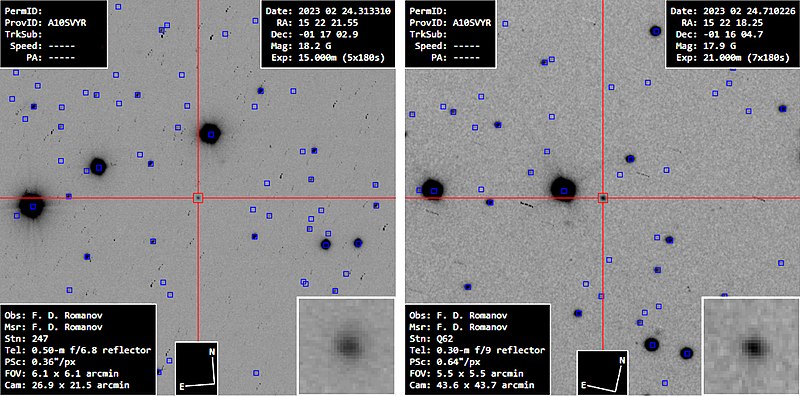
Comet A3 in social media
This is an absolutely amazing simulation of the behavior of Comet C/2023 A3 (Tsuchinshan-ATLAS) by @nlefaudeux ? #Comet #Astronomy #TsuchinshanATLAS #Cometa #CometC2023A3 #Tsuchinshan #C2023A3 #FollowTheComet pic.twitter.com/lpAWezXzp4
— Yuri Beletsky (@YBeletsky) September 27, 2024
Getting up at 4am to see Comet Tsuchinshan-ATLAS rising over the Toowoomba range
— George Zhou (@georgezhouastro.bsky.social) September 22, 2024 at 3:54 PM
Comet C/2023 A3 (Tsuchinshan-ATLAS) is finally here ! ???I captured this image this morning at 09:22 UTC from @LCOAstro in Atacama desert in Chile ?? The view was absolutely spectacular ! The clouds were constantly moving just above the horizon, but we got really lucky when the… pic.twitter.com/AoClHkatFr
— Yuri Beletsky (@YBeletsky) September 24, 2024
So far Comet Tsuchinshan-ATLAS looks like a fuzzy star to the naked eye looking out the cupola windows. But with a 200mm, f2 lens at 1/8s exposure you can really start to see it. This comet is going to make for some really cool images as it gets closer to the sun. For now a… pic.twitter.com/JstaSLJ4Ui
— Matthew Dominick (@dominickmatthew) September 19, 2024
It’s already possible to barely see the Comet C/2023 A3 (Tsuchinshan-ATLAS) from northern locations but faint and very very low over the horizon.
Inages:
Left: 21/9/24 by Val Italo from Atlanta, USA
Right: 22/9/24 from Canary Islands by Frank A. Rodríguez @AstroEduca pic.twitter.com/Kh1WqDhx5K— Xavi Bros (@Xavi_Bros) September 23, 2024
Bottom line: Comet A3 Tsuchinshan-ATLAS isn’t the only possible comet for the coming month. There are two comets that might become bright in October 2024.
Source: Inevitable Endgame of Comet Tsuchinshan-ATLAS (C/2023 A3)
